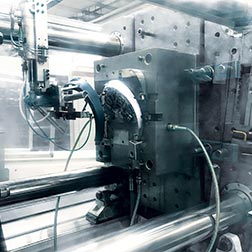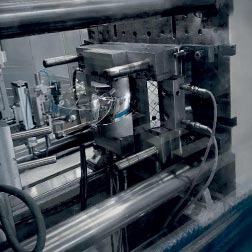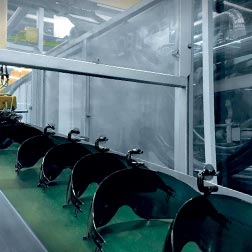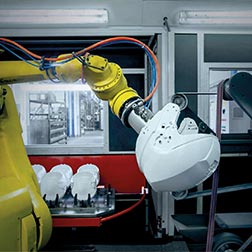All of the stages of the production cycle are managed from within the company: from the receiving of the raw materials to the final assembly of the product. This ensures the constant evolution of production technology and the maintaining of the highest standards in quality.These stages include: the moulding and finishing of the outer shell, be it in polycarbonate or composite fibre, the moulding of all the internal components in polystyrene, the moulding of the visor and the carrying out of the relative scratch-resistance treatment, as well as the cut and siliconizing of the inner-visor for resistance to fogging, the moulding of the sun screen and the carrying out of the relative scratch and fogging resistance treatment, the moulding of various complementary plastic components, for example the air intakes and visor mechanisms, the painting and the application of graphics, the production of retention systems and the cutting and preparation of comfort inner padding, and the final assembly of the product.Below is a brief detailed description regarding the production of the outer shell, in terms of materials and processes..
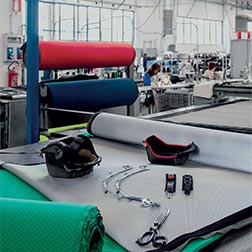
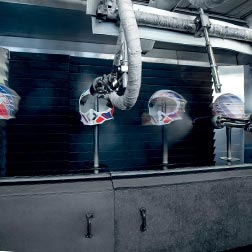
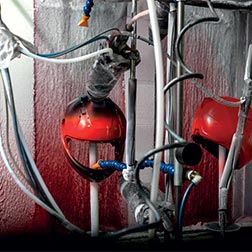
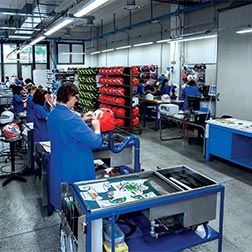
The production of the outer shell for X-lite helmets is based on the use of multi-axial hybrid fabrics (carbon-glass and aramid-glass) which are cut in order to produce over 100 reinforcement pieces which form the base of the layers of the shell, or rather of the manual combining of the aforementioned pieces according to pre-established “recipes”, which differ based on the homologation required, the model and the size of the product. This is followed by the moulding of the shell: a thermosetting resin is poured into the layered mould and, via pressure from a countermould, is hardened, absorbing and binding the fabrics. After this stage, the process continues with the various activities of finishing of the shell, beginning with cutting using a numerically-controlled water jet. The clean cutting of the shell takes place at high pressure, approximately 4,000 bar: during this stage, openings are cut, for example, for the visor and the air intakes. The cycle ends with further activities for finishing: automatic sanding by robot, followed by visual checks and manual finishing to render the surface of the shell even, thus preparing it for painting. The constant commitment of the company to the search for materials and processes which ensure ever-improved performance for the products has, over the last few years, led to the creation of the “Ultra Carbon” line: products which are characterised by reduced weight for the same size and mechanical performance, as well as for an exclusive look, thanks to the “visible” fibres. The development of this line therefore requires the use of special fabrics, as well as extreme manual care in the aforementioned finishing stages for the shell.
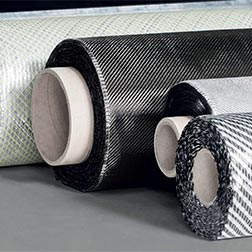
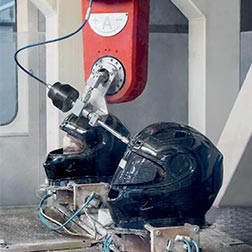
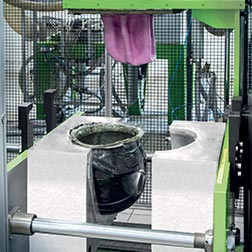
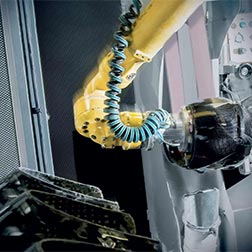
The production of the outer shell for Nolan and Grex brand helmets occurs trough LEXAN™* polycarbonate injection moulding process. LEXAN™* is a material ensuring, for the same shape, thickness and process, higher performance compared to ABS, the raw material used for the moulding of almost all motorbike helmets on the market. The polycarbonate provides superior performance in both mechanical and thermal terms: during impact resistance tests, the polycarbonate obtained results of 900/1000 J/m, compared to the maximum results of 550/600 J/m for ABS. Furthermore, the thermal range of the polycarbonate is between -30°C to +120°C compared to a range of -20°C to +50°C for ABS. At 80°C (the temperature that the helmet may be required to endure in the summer, closed in a pannier), the polycarbonate remains stable, while ABS undergoes deformation; at 100°C, LEXAN™* still maintains its dimensional stability, while ABS deforms completely. The same test carried out at -20°C shows how LEXAN™* does not suffer cracks at harsh temperatures, while ABS becomes very fragile.
